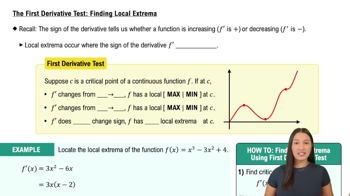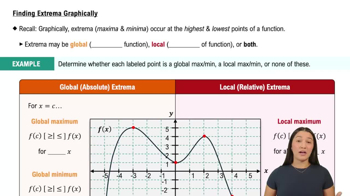Table of contents
- 0. Functions7h 52m
- Introduction to Functions16m
- Piecewise Functions10m
- Properties of Functions9m
- Common Functions1h 8m
- Transformations5m
- Combining Functions27m
- Exponent rules32m
- Exponential Functions28m
- Logarithmic Functions24m
- Properties of Logarithms34m
- Exponential & Logarithmic Equations35m
- Introduction to Trigonometric Functions38m
- Graphs of Trigonometric Functions44m
- Trigonometric Identities47m
- Inverse Trigonometric Functions48m
- 1. Limits and Continuity2h 2m
- 2. Intro to Derivatives1h 33m
- 3. Techniques of Differentiation3h 18m
- 4. Applications of Derivatives2h 38m
- 5. Graphical Applications of Derivatives6h 2m
- 6. Derivatives of Inverse, Exponential, & Logarithmic Functions2h 37m
- 7. Antiderivatives & Indefinite Integrals1h 26m
- 8. Definite Integrals4h 44m
- 9. Graphical Applications of Integrals2h 27m
- 10. Physics Applications of Integrals 2h 22m
5. Graphical Applications of Derivatives
Intro to Extrema
Problem 4.1.57
Textbook Question
Absolute maxima and minima Determine the location and value of the absolute extreme values of ƒ on the given interval, if they exist.
ƒ(x) = 2x³ - 15x² + 24x on [0,5]
 Verified step by step guidance
Verified step by step guidance1
First, find the derivative of the function ƒ(x) = 2x³ - 15x² + 24x to determine the critical points. The derivative, ƒ'(x), is calculated using the power rule: ƒ'(x) = 6x² - 30x + 24.
Set the derivative ƒ'(x) equal to zero to find the critical points: 6x² - 30x + 24 = 0. Solve this quadratic equation using the quadratic formula or factoring to find the values of x.
Evaluate the function ƒ(x) at the critical points found in the previous step, as well as at the endpoints of the interval [0,5]. This means calculating ƒ(0), ƒ(5), and ƒ at each critical point within the interval.
Compare the values of ƒ(x) obtained from evaluating the function at the critical points and endpoints. The largest value will be the absolute maximum, and the smallest value will be the absolute minimum on the interval [0,5].
Conclude by stating the location (x-value) and the value of the absolute maximum and minimum based on the comparisons made in the previous step.
 Verified video answer for a similar problem:
Verified video answer for a similar problem:This video solution was recommended by our tutors as helpful for the problem above
Video duration:
6mPlay a video:
Was this helpful?
Key Concepts
Here are the essential concepts you must grasp in order to answer the question correctly.
Critical Points
Critical points are values of x in the domain of a function where the derivative is either zero or undefined. These points are essential for finding local maxima and minima, as they indicate where the function's slope changes. To locate absolute extrema on a closed interval, one must evaluate the function at these critical points as well as at the endpoints of the interval.
Recommended video:

Critical Points
First Derivative Test
The First Derivative Test is a method used to determine whether a critical point is a local maximum, local minimum, or neither. By analyzing the sign of the derivative before and after the critical point, one can infer the behavior of the function. If the derivative changes from positive to negative, the critical point is a local maximum; if it changes from negative to positive, it is a local minimum.
Recommended video:

The First Derivative Test: Finding Local Extrema
Evaluating Endpoints
When finding absolute extrema on a closed interval, it is crucial to evaluate the function at the endpoints of the interval in addition to the critical points. The absolute maximum or minimum could occur at these endpoints, especially if the function is not continuous or differentiable throughout the interval. Thus, comparing the function values at critical points and endpoints ensures that all potential extreme values are considered.
Recommended video:

Evaluate Logarithms

 5:58m
5:58mWatch next
Master Finding Extrema Graphically with a bite sized video explanation from Callie
Start learning





